This excerpt on warm-up exercises for equestrians was adapted from the book Rider Fitness: Body and Brain from Trafalgar Square Books.
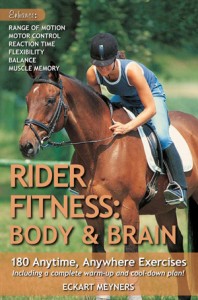
Rider-Specific Warm-Up Exercises for Equestrians
Goal: This type of warm-up exercise for equestrians is directly connected to riding and decreases muscle viscosity, reduces muscle tension, and prepares for coordinative processes in your body.
Riding-Specific Exercises
The exercises presented here are intended to create perfect energetic, psychological, and coordinative conditions for riding at peak performance. First, I will introduce you to exercises that optimize your brain functions while balancing energy between your body “halves” (left/right, top/bottom, back/front). The exercises improve your cross-coordination (the ability to work across your body’s midline).
Movements that are generally problematic for many individuals today include rotational motions around the midline, as well as diagonal patterns. If your body cannot easily rotate to the side in both directions, you will hardly be able to follow your horse as he travels on curved lines, such as circles and turns. Your outside (outside the bend) shoulder cannot follow the movement of the rest of the body—it lags behind and you will no longer find yourself in the desirable and correct posture where your shoulders are parallel to the horse’s, and your pelvis parallel to his.
Warm-up exercises to train these kinds of coordination skills have already been introduced in the section on your general warm-up (skipping and moving sideways while rotating your hip area, for example). Before moving on with exercises specific for warming up the rider in particular, it is important to stimulate the brain and energy meridians (pathways), since all muscle functions originate in the brain and are dependent on energy flow. Therefore, the exercises you need to do now should not only school your body but more importantly, your brain.
Kinetic Exercises to Improve Cross-Coordination
Opposite Stretch
Alternate stretching your left arm/right leg with stretching your right arm/left leg, moving them forward, backward and sideways (at left). Your eyes should follow your movements in all directions. Lift your foot to one side behind the opposite leg, and reach back and touch it with your opposite hand. Switch sides, and repeat multiple times so your hands have to cross into the lower half of your body on both sides. In the same way, you can bring your knee up in front of you, to one side or the other, and grab it with the opposite hand.
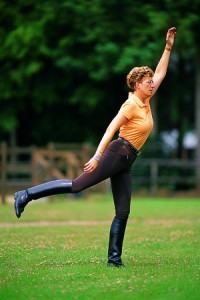
Lazy Eight
Focus on a visual reference point directly in front of you at eye level. This point will be the center of a horizontal figure eight. Stretch one arm out in front of your body in a comfortable manner, and begin “writing” horizontal figure eights in space (illustration at right). You can decide on the height and width of the figure eights, but the best result is achieved if you create one large enough to extend across your entire field of vision and that requires you to use the full mobility of your arm. In order to stimulate the right cerebral hemisphere, start with your left arm pointing at your focal point, and then move it counterclockwise toward the top left half of the eight before moving it in a smooth circular motion back to the center starting point and through to the top right corner of your field of vision and again in a circle back to center. Repeat at least three times and switch arms (photo at left).
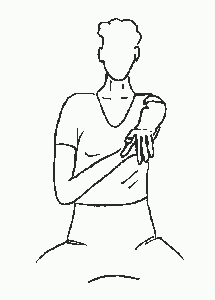
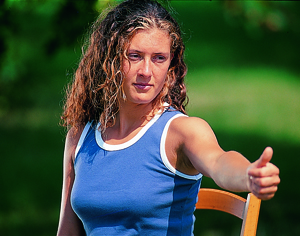
You can also do this exercise with your eyes closed. Humming might support the process. Your head (your eyes) should follow the movement to a small degree while your neck remains relaxed.
Cross-Crawling
Crawl on your hands and knees, then on your elbows and knees, and at lastly, crawl on your stomach (photo at right).
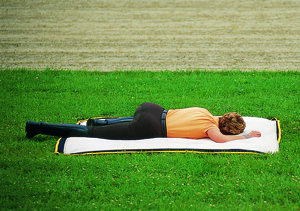
Exercises to Reduce Stress
Every rider should “de-stress” before working with her horse, taking a lesson, or competing, in order to mentally prepare to be the best rider possible. I suggest the following techniques, which are easy to follow and create a sound stress-relief foundation to build upon.
Smiling
As a rider, you can positively support your efforts in the saddle simply by smiling. When you smile, you activate muscle chains running from your face through your neck area, and your pelvis all the way to your feet. A rider who is smiling will naturally follow the horse’s movement with her body.
Positive Thoughts
Besides smiling, pleasant thoughts and feelings improve the suppleness of your seat—only a relaxed rider is able to maintain the balance in her own body and in her horse’s. This state of relaxed balance is the prerequisite for sensitive and subtle riding.
Tongue-to-Palate
Due to its stress regulating function, the human tongue plays a special role with regard to the promotion of sensitive riding. When the tip of your tongue is pushed against your palate about one-fifth of an inch behind the incisors, your body’s energy is maintained; all energy is “centered.”
During riding, you should always pay attention to the tongue’s function. It contributes to your balance and should be included in the basic effort of trying to achieve a sensitive seat.
Try this exercise to see this phenomenon for yourself: Stand on one leg and ask a friend to gently pull on your arm. You will quickly lose your balance. Do the same experiment this time with your tongue pushing against your palate, and you will be surprised how steadily you are able to stand. Your friend will have to apply a lot more effort to disturb your balance.
Tapping the Breastbone
Your thymus is a specialized organ of the immune system. It is located behind the breastbone (sternum) and in front of the heart. I find that tapping against your breastbone in the area of the thymus relieves stress (photo at left). Using your knuckles, tap your breastbone a couple of times, several times a day, in order to protect yourself from sources of stress of which you may be unaware. And, in situations that you know to be anxiety producing, this mechanism will allow you to get rid of accumulated stress.
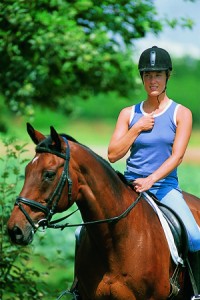
Humming
Human beings constantly experience vibrations throughout their body. When you are stressed, these vibrations are amplified and can make you physically shake. When the vibrations are too low, you behave apathetically and may not act or react in a timely or appropriate manner. When the level of body vibrations is ideal, a balance is struck.
You have probably found yourself in situations—in and out of the saddle—in which you could no longer achieve certain motions you had performed successfully many times in the past, and it may have been due to the level of vibrations in your body (too high or too low). In situations like these, humming can play an important role by reactivating subconscious movement patterns. Humming is also a good way to shield yourself from pressure or criticism—it releases tension rather than bottles it up. I know of several Grand Prix riders who have incorporated both humming and tapping their breastbone into their basic riding practices with successful results.
Read more about the whys and hows of a rider warmup in the October 2011 issue of Practical Horseman magazine. To purchase a copy of this book, go to www.EquineNetworkStore.com.










